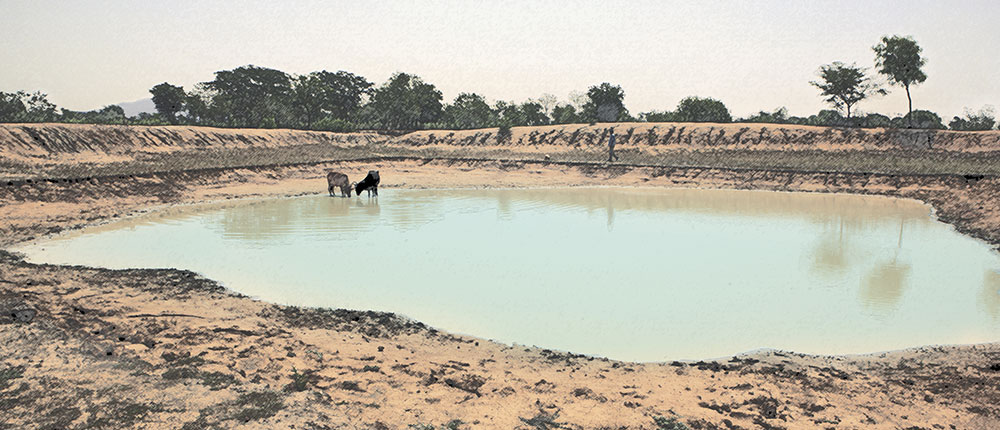
At the behest of the Ministry of Environment, Forest and Climate Change, ISRO’s Space Applications Centre, Ahmedabad along with partner institutes took up the task of inventorising and monitoring of land degradation and desertification in India using Indian Remote Sensing Satellites (IRS) data. The analysis reveals that 96.40 million hectares (mha) area or 29.32% of the Total Geographic Area (TGA) in India is undergoing a process of land degradation during 2011-13, which is an increase of 1.87 mha area or 0.57% of TGA since 2003-05.
Nature and extent of land degradation in India
The earliest assessment of the area affected by the land degradation was made by the National Commission on Agriculture in 1976 at 148 M ha i.e. 45% out of the Total Geographical Area (TGA) of 328 mha, followed by 175 mha by the Ministry of Agriculture (Soil and Water Conservation Division). The National Bureau of Soil Survey and Land Use Planning (NBSS&LUP) estimates projected an area of 187 mha as degraded lands in 1994, and revised it to 147 mha in 2004.
The National Wasteland Development Board (NWDB) in 1988 estimated an area of 123 mha (37.5% of TGA) under degraded/wastelands based on National Remote Sensing Agency (NRSA) satellite data of 1984-85. The “top down” and “bottom up” approaches of NRSA and NBSS&LUP data was partially harmonized (incorporating causative factors) with respect to 114 mha (34.75 of TGA) of degraded/wastelands.
Drivers and causes of land degradation and desertification in India
At a broad level, the driving forces behind land resources may be described as follows. Some of the drivers are natural, others are anthropogenic. Even the “natural” drivers may have anthropogenic influences which may modify or exacerbate the drivers and the impacts:
- Wind erosion
- Water erosion (fluvial, meteoric)
- Chemical (natural occurrence of alkaline chemicals, movement of subsoil chemicals (e.g. salinity) to the surface, as well as artificial addition of chemicals, including fertilizers or industrial pollutants)
- Physical (waterlogging, geomorphological changes caused by mining or other activity)
Direct anthropogenic influences and drivers include:
- Agriculture, and related activities
- Livestock related activities (grazing)
- Biotic pressures (for fuelwood and fodder and MFP)
- Land Use changes (urbanisation, mining, infrastructure, etc.)
Soil erosion by wind and water which removes topsoil with its organic content, as well as acidity, alkalinity/salinity of the soil which makes the soil toxic for agriculture and other uses are the principal causes for land degradation. Waterlogging, due to natural flooding as well as irrigation, is another significant cause of degradation, both by inundation, and in some cases, by bringing up subsoil toxic chemicals (evaporites) to the soil surface.
As agriculture uses 141 million hectares out of 328.7 mha of the country, faulty land and water management practices in agriculture significantly contribute to land degradation. There is enough scientific evidence to show that intensive irrigation and high chemical use (fertilizers, pesticides, etc.) adds to degradation and that certain subsidies (such as the provision of free electricity and free irrigation water) worsen the situation. Rainfed agriculture spans several agro-ecological regions and constitutes 60% of total cropped area. Soils in rainfed areas, particularly the drylands, are subject to a prolonged double exclusion, being unable to gain from full use of chemical fertilizers and receiving no support for locally validated fertility-enhancing practices like crop residue incorporation, composting, farmyard manure application, etc.
While judicious management of common lands which are generally not brought under agriculture can avoid erosion and other complex degradation problems, sustainable use of common land and revitalisation of degraded common lands requires deep community level commitments, which may be lacking given the social inequalities and competition for access to scarce resources. In India, the poor and tribal communities in the vicinity of forest areas depend quite heavily on forest produce for all aspects of their day to day life. Ensuring sustainable management of forests requires a due attention to the needs of communities in and around forests.
Evolution of land resource management policies and approaches
Though the subjects of “land”, “agriculture” and “water” are subjects with the States as per the Constitution, the concerns for arresting and reversing land degradation and desertification have been reflected in many of the national policies for nearly 40 years. Current policies and key legislation (many of them revised versions of earlier policies) include The National Water Policy 2012; National Forest Policy 1988; National Agricultural Policy 2000; Forest (Conservation) Act 1980; Environment (Protection) Act 1986; National Environmental Policy 2006; National Policy for Farmers 2007; National Agroforestry Policy 2014 etc which have enabling provisions for addressing these problems.
The evolution of schemes and programmes to address the various aspects of land degradation actually reflect the progressive acquisition of knowledge and development of improved packages of practice, as well as the shifts in focus based on national priorities. Some of the key milestones along this process include:
- Adoption of watershed approach and planning based on micro-watersheds; use of remote sensing data and spatial data in planning at the micro-watershed level
- Integrated treatment incorporating contouring, gully plugging, vegetative as well as engineering-based solutions for soil-moisture conservation, covering agricultural as well as non-agricultural lands. Joint Forest Management (JFM) and Social Fencing by involving local communities.
- Integrated farming based approach incorporating fodder and fuelwood supply, farm-forestry and agroforestry and silvi-pastures; stall feeding, improved chullahs etc.
- Focus on water management, aquifer recharge and water budgeting as well as crop planning
- Focus on social aspects: participative planning at micro-watershed level; transect walk; Constitution of Watershed Committee under the Gram Sabha; Water User Association development; social audit.
- Incorporation of livelihood related activities and development of micro-enterprises; involvement of Self-Help Groups (SHGs); programmes such as Mahila Kisan Sashaktikaran Pariyojana (MKSP) focusing on increasing capabilities women farmers with a view to increasing sustainability.
- Adoption of climate-adaptation related solutions both with regard to floods and intense precipitation as well as temperature and moisture stress, and orienting employment generation programmes like MGNREGA in this direction.
- Increasing the role of Panchayati Raj Institutions (PRIs) and ensuring “convergence” between Government programmes and programmes executed by PRIs.
Unfinished tasks and the way forward
Though it would seem that there has been very substantial development with regard to the national imperative of checking land degradation, the visible impact of programmes on the ground is clearly less than impressive. A provisional diagnostic would suggest:
- Insufficient coverage by government programmes for addressing land degradation primarily because of funding constraints but also because of management and technical capacity constraints.
- Need to focus on more sustainable agricultural practices. Depleting groundwater, the spread of problem soils (acidic, saline & alkaline), loss of soil organic carbon (SOC) and yield plateaus manifest the different dimensions of the problem and challenge.
- Perverse incentives such as free power for groundwater pumping; nitrogenous fertilizer subsidy; Minimum Support Price (MSP) only for a few crops (thus influencing crop choice) etc. may be causing degradation of additional areas.
In the last analysis sustainable management of land (and water) resources have to be by, and in close collaboration with, local communities. It is no coincidence that the few outstanding examples of sustainable management are all traceable to visionary local leadership supported by the host communities and assisted by public policies for sustainable use of resources, infrastructure creation, knowledge accretion and transmission, and development of entrepreneurship. Checking and reversing land degradation has to be essentially based on self-regulatory practices with regard to a sustainable use of resources and energy. The task of public policies must include incentivisation of such regulation.


